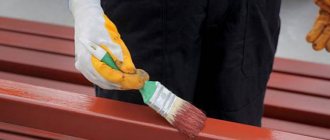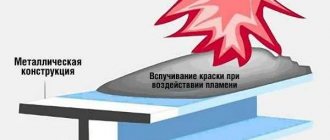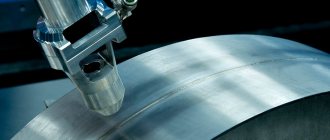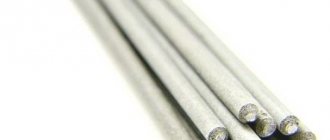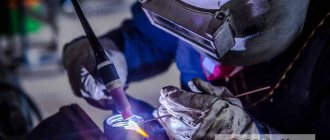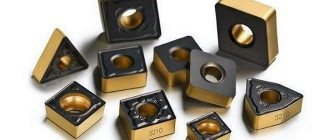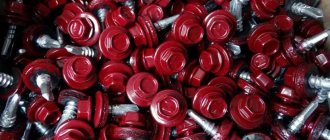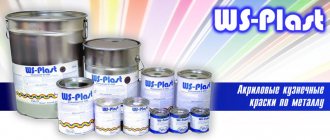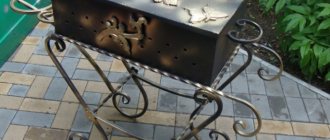In addition to the “urgent” requirements for paintwork materials in the form of a protective function, the creative and aesthetic components are important. One of the popular trends is to give paint additional decorative qualities. The properties of paint and varnish coatings, which consist in the ability of paint, in addition to color, to impart various effects to the surface, are used both in the production of products and in planning the appearance of facades and residential premises. The so-called “hammer effect” is imparted to the painted surface by hammer paint on metal, which, when formed as a film, forms beautiful patterns in the form of embossing.
Technical characteristics of hammer paint
- Density – 1 kg/liter.
- Drying time is two hours.
- Shelf life – 2 years.
- Consumption 1 liter per 10 sq.m. in one layer.
- Applying several layers requires waiting up to five hours.
- Withstands temperatures up to +90°C.
- Gloss level - 66.
Benefits of hammer paint
- Not afraid of temperature changes;
- Dries quickly;
- Guaranteed protection against corrosion for up to 9 years;
- Resistant to mechanical damage;
- Can be applied to rust;
- Does not fade;
- Has water-repellent properties;
- Resistant to stains, easy to clean;
- Masks roughness and unevenness, hides chips;
- Wide range of colors;
- Does not emit toxic odors or substances harmful to humans.
Disadvantages of hammer paint
- Difficult to remove if necessary, special abrasives and tools are required;
- High consumption;
- High price;
- If an area with rust is missed after application, corrosion will transfer to the paintwork;
- Poor application from a spray bottle.
What it is
Hammer paint is a decorative paint coating for metal surfaces. It is often chosen for painting car bodies due to its aesthetic and performance characteristics. The material is resistant to temperature changes and mechanical damage. The treated surface acquires an unusual texture - as if it had been hit many times with a small hammer. The name comes from this effect.
Hammer-effect metal paint is sold in two forms: liquid in cans or buckets and aerosol in cans.
Hammered paint
Where is hammer paint used?
Because hammer paint effectively resists corrosion, it is often used in metallurgy and blacksmithing.
Most often used for:
- Entrance doors and gates;
- Electrical panels and other metal cabinets;
- Forged benches, tables and other products;
- Laboratory equipment;
- Safes and safe deposit boxes;
- Car parts;
- Pipe
In modern construction, hammer coating is applied to wood, hard plastic, glass and ceramics.
Area of use
- Forged products, decorative items made of cast iron.
- Metal doors, fencing, fences, gates.
- Cars and mechanisms – car parts, electrical panels, etc.
- Steel structures – such as weather vanes, pipes, beams, support structures, fastenings.
- Furniture – cabinets, safes, benches, etc.
- Decorative items - frames, fittings, artistic forging, equipment and much more.
- Production equipment, specialized devices, racks, shelves.
Materials: can be painted on wood, metal, glass, tiles, plastic.
Important! Hammer painting involves applying the mixture to a horizontal surface. Therefore, before painting a metal door, remove it from its hinges and lay it flat. Otherwise, the paint may form smudges. If this is not possible, you can purchase a quick-drying option. Pay special attention to this!
Painting a metal structure for stairs. Video
Types of hammer paint
There are several types of blacksmith paint. They differ in the additional additives included in the composition.
- NTs-221. It's inexpensive. Not suitable for coating rusty elements. Rather, it serves a decorative function. Can be used both externally and internally. Does not tolerate high temperatures.
- ML-165. Tolerates heating up to + 120°C. Fits well on any surface. Sets quickly.
- Hammerite. Made in England. It is characterized by high cost. Suitable for application on rust.
- Enamel 1323. It is a combination of paint and primer at the same time. Widely used in the automotive industry. Can be applied to rust without pre-treatment.
Drying time
Information about how long the paint takes to dry is given in the instructions for use. On average, this takes 2 hours, after which the coating ceases to be sticky. But the enamel gains maximum strength after 2-3 days.
After painting the car, it is recommended to refrain from operating it during this time.
The influence of these factors depends on the manufacturer. Thus, Dali enamel from NPP Rogneda can be applied to stainless steel and non-ferrous metals without a primer. Hammerite products do not hold up well under these conditions.
How to choose hammer paint
When choosing a coating, you need to pay attention to the following factors:
- Application area. For outdoor use, paintwork materials must be moisture- and temperature-resistant. In addition, the coating should not be subject to fading.
For interior work, first of all, you need to pay attention to toxicity. The paint should not have a strong odor.
- Quick-drying compounds are suitable for application to vertical surfaces;
- If you plan to apply the paint using a sprayer, you need to choose a liquid consistency;
- When applying aerosols, consumption may increase, so it is better to purchase paint with a reserve;
If it is intended to be used in the interior, the color of the coating should be in harmony with the surrounding design.
Consumption per 1 m²
The component composition of each paint is selected individually, so the consumption per 1 m² often varies. In addition, the application process is influenced by:
- Temperature and humidity.
- Processing method.
- Condition of the base.
We present in the table the amount of consumption for the products of each popular brand:
| № | Name | Packing | Consumption, ml/m² |
| 1 | Alpina Direct | Can 0.75 l; 2.5 l | 100-120 |
| 2 | Dali 3 in 1 | Can 0.75 l; 2 l | 83 |
| 3 | Dufa Hammerlack | Can 0.75 l; 2.5 l | 142 |
| 4 | Hammerite hammer | Jar 0.25 l; 0.75 l; 2.5 l; 5 l | 100 |
| 5 | Kudo aerosol | 0.52 l can | 520 |
| 6 | Panzer straight to rust | Jar 0.25 l; 0.75 l; 2.3 l | 125 |
The consumption of the composition is indicated taking into account processing in 1 layer. The average value can be taken as 150 ml/m².
Surface preparation
You can even apply hammer paint to a rusty surface or old coating. The exception is oil and powder paints.
But for better adhesion, it is recommended to carry out the following preparatory work before application:
- New metal parts should be cleaned of factory grease. To do this, they need to be thoroughly washed with white spirit and wiped with acetone. Then clean it with sandpaper or a metal brush.
- If the elements have old paintwork, it is necessary to clean all chips, cracks and flaking pieces. Then wash with a solution of washing powder and dry.
- If a part is covered with old rust that crumbles when touched, it needs to be cleaned. Otherwise, the hammer paint will not be able to adhere to the surface.
- Objects made of non-ferrous metals, aluminum and stainless steel must first be coated with a special primer.
- Wooden products are treated with water-based acrylic primer. Otherwise, the paintwork will be absorbed into the structure of the wood and you won’t get a beautiful shagreen effect.
Is it possible to make blacksmith enamel at home?
Since this enamel has a high cost, enterprising owners figured out how to make paint at home. If you want to benefit from their expertise, you need to prepare the following tools and components in percentage:
- UVL-1 varnish: 96.8%;
- metal shavings from aluminum – up to 6% maximum; 0.5% soot;
- silicone oil;
- capacity;
- construction mixer or electric drill with an attachment for stirring solutions;
- latex gloves.
Soot contributes to the formation of shade and relief, but the hammer effect is achieved through aluminum shavings. Silicone oil is necessary to form the hard particles that make up the texture of the enamel.
Manufacturing Features
Oil enamels are mixed in a warm room. It is advisable to do this in a specialized painting chamber. Combine all ingredients except silicone oil, it is added at the end of mixing.
First, stir the mixture with a wooden stick, spatula or other tool. Now mix with a mixer until the chips become a homogeneous mass. That is, it should not float to the surface of the solution.
To change the shade, you can add enamel of any color, but remember, it should not exceed 30% of the total mass. Dilute the resulting mixture with silicone oil in the amount of 5-8 drops.
Whatever method you choose: ready-made paint or homemade paint, you will get an interesting textured surface in an industrial style.
How a metal entrance door can be painted can be done in a special article. We also recommend looking at special compounds, such as anti-vandal coating for walls.
Features of applying hammer paint (step-by-step instructions)
When choosing an application tool, you should proceed from the tasks and volume of work.
Brush
Perfect for painting small elements and hard-to-reach places. Easy to use, does not require additional skills.
The paint is applied in a thick layer, and the hammer effect appears especially clearly. At the same time, the consumption of paints and varnishes is minimal.
The disadvantages include the low speed of work. Inability to paint large surfaces evenly. There is also a risk of leaving gaps and smudges on vertical parts.
Roller
Only suitable for large surfaces without hard-to-reach areas. Paint consumption increases significantly.
Foam tips cannot be used. The composition corrodes this material and pieces of foam rubber, smudges and stains will remain on the painted surface. Preference should be given to a short-pile fur roller.
Spray gun
The painting process will take the least time, and the application will be of high quality. To create a smooth finish without smudges, experience with this tool is required. Allows you to paint hard-to-reach places.
- Hammer paint for use with a spray gun must be diluted to a liquid consistency.
- Therefore, for a high-quality coating you will have to apply several layers.
- Each subsequent layer can be applied after the previous one has completely dried. Paint consumption will increase accordingly.
When working, it is better not to use power tools, because... The paintwork material has a high density, and the spray gun may not have enough power for application.
Color palette
Initially, the hammer composition was used only for processing tools, and only a gray solution was produced. Nowadays, the demand for paint has increased due to its good properties, and manufacturers offer a wide palette of shades. You can find brown, black, white, green, red, and more, so finding the right type should be easy.
For a small amount of work, you can use spray cans, which are convenient to take with you.
Any shade will have a shiny finish; the textured layer makes the paint look attractive; there are matte types.
Nowadays, the demand for paint has increased due to its good properties, and manufacturers offer a wide palette of shades.
Photo of hammer paint
Tips for painting
For optimal application, after preparation it is necessary to add nitro 646 or 645 thinner. This substance does not affect the quality of the paint or the appearance of the coating. It is important to stir evenly before application. The prepared mixture can be applied to a metal surface using a roller, brush, special can, or sprayer. The optimal layer thickness should be no more than 100 microns.
Important. If painting is done using a spray can, then according to the rules it must first be shaken well.
When painting large structures that occupy significant areas in size, a special spray gun is used.
In this case, the solvent is added to the mixture in a 2:1 ratio. At ambient temperatures below 20°C, the proportions should be adjusted. When paint is diluted in order to treat car parts from rust, the proportion is maintained as 9:1.
When a surface is painted using a spray gun, the apparatus must be held at a right angle to the surface to be painted. For safety reasons, it is important to use personal protection, which includes: goggles, gloves and a high-quality respirator.
It is also important to follow several basic rules when painting:
- The roller is not dipped in paint, but rather the opposite: a small amount of paint is poured onto the roller.
- Roller covers should not be made of foam rubber, otherwise such material will be destroyed.
- The second one should be applied strictly after the first one is completely dry.
- Metal parts with complex surfaces must be painted with a brush.
- In places where there are welding seams, it is recommended to apply an order of magnitude more composition.
- When applying, it is important not to use a large amount of the composition so that large layers of paint do not occur.
If you follow safety rules, as well as carefully paint all small surfaces and parts, you will create an even, dense layer of paint that will successfully protect the surface from corrosion and aggressive environmental influences.
Device from a car camera
If you plan to paint a small area, for example, the body of a car, then you can build a spray gun from an old car camera. It will serve as a receiver, that is, a vessel for accumulating air.
This paint spraying device, in addition to the car camera, is assembled from:
- car pump;
- pressure gauge;
- a nipple from another old camera;
- two fittings.
When making a spray gun from a car camera, you need to complete the following points:
We check if there are any punctures in the chamber by inflating it with a pump. If air escapes from the chamber in some place, the rubber part is repaired;
You can use an old camera
We make a small hole in the receiver without punctures
It will become a place for attaching an additional nipple, from which a compressed air stream will emerge; We insert an additional fitting into the formed hole, carefully fixing it with adhesive. After this, the fitting can be connected to a household sprayer; Trying to unscrew the nipple
If the air flies out slowly, then the work was done flawlessly; We screw the nipple to the original nipple on the camera. It is assigned the role of a valve that lowers the pressure if it is too high; Determine the air pressure in the chamber. An intermittent (excessive) behavior can be indicated by a pressure gauge.
